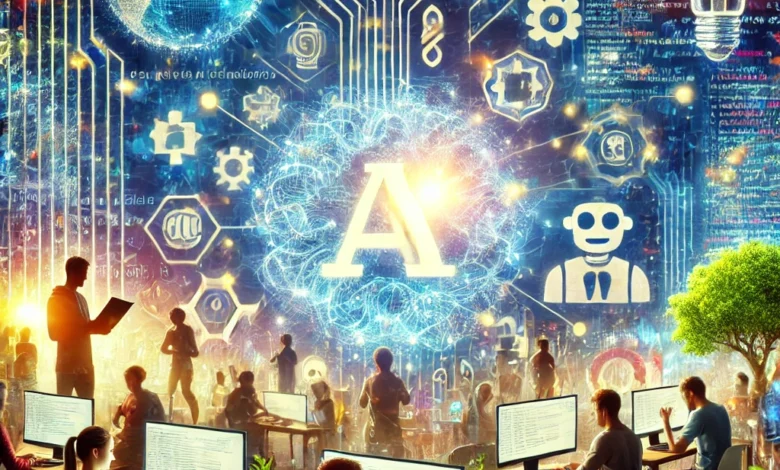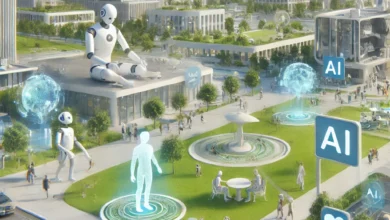Embracing the Future: How Programming Languages are Shaping the World for the Better

Introduction
In today’s rapidly advancing technological landscape, programming languages have become the backbone of innovation and progress. From the simplest mobile apps to the most complex artificial intelligence systems, programming languages enable developers to bring their ideas to life, transforming them into tangible solutions that enhance our daily lives. These languages, though often unseen and unheard by the general public, are the invisible forces driving the digital world. They have revolutionized industries, empowered individuals, and created countless opportunities for growth and development.
As we look around, it’s clear that the impact of programming languages goes far beyond the tech industry. They have become essential tools for solving some of the world’s most pressing challenges, from improving healthcare outcomes to combating climate change. Programming languages are not just about code; they are about creativity, problem-solving, and innovation. They represent a world of possibilities, where anyone with the right skills can make a difference.
In this blog, we will explore the positive impact of programming languages on society. We’ll delve into their evolution, their role in empowering developers, and their contributions to various industries. We’ll also examine how they are improving accessibility, promoting sustainability, and what the future holds for these powerful tools.
The Evolution of Programming Languages
The journey of programming languages is a testament to human ingenuity and the relentless pursuit of progress. From the early days of assembly language to the sophisticated, high-level languages we use today, programming has come a long way. The evolution of programming languages reflects our growing understanding of computing and our desire to make technology more accessible and powerful.
In the beginning, programming was a laborious task, requiring knowledge of binary code or assembly language. These early languages were powerful but difficult to master, limiting the number of people who could create software. As technology advanced, so did the languages used to control it. The development of high-level programming languages like FORTRAN and COBOL in the 1950s marked a significant leap forward. These languages allowed programmers to write code using more natural language constructs, making it easier to learn and use.
The 1970s and 1980s saw the rise of languages like C and Python, which further simplified programming while maintaining power and flexibility. C, with its efficient memory management and portability, became the foundation for many modern operating systems, while Python’s simplicity and readability made it a favorite among beginners and experts alike.
In the 21st century, the evolution of programming languages has accelerated, with a focus on improving developer productivity and code quality. Languages like JavaScript, Swift, and Kotlin have emerged, offering powerful tools for building everything from web applications to mobile apps. Meanwhile, languages like Rust and Go have introduced new paradigms that prioritize safety and performance, reflecting the changing needs of the tech industry.
The continuous evolution of programming languages is driven by the desire to create better, more efficient, and more accessible tools for developers. As technology continues to evolve, so too will the languages we use to shape it, ensuring that they remain at the forefront of innovation.
To know FAQs about programming languages, visit https://dinogeek.me/
Empowering Developers and Innovators
One of the most remarkable aspects of programming languages is their ability to empower developers and innovators. With the right tools and knowledge, anyone can turn an idea into a reality, and programming languages are the keys that unlock this potential. The democratization of programming through open-source languages and platforms has enabled a new generation of developers to create impactful solutions, often with limited resources.
Consider the story of a small startup that used Python to develop an AI-driven application for diagnosing medical conditions. This application, built with the help of a programming language known for its simplicity and power, has the potential to save lives by providing early diagnosis in regions with limited access to healthcare professionals. This is just one example of how programming languages can empower individuals to make a significant impact on the world.
Open-source programming languages like Python, JavaScript, and Ruby have played a crucial role in fostering innovation. By making the source code freely available, these languages encourage collaboration and knowledge sharing, allowing developers from around the world to contribute to and benefit from each other’s work. This collaborative environment has led to the rapid development of new technologies and has lowered the barriers to entry for aspiring developers.
Moreover, programming languages have enabled the rise of independent developers and small teams who can compete with larger corporations. The proliferation of app stores and online platforms has created opportunities for individuals to distribute their software to a global audience, often with minimal investment. This shift has led to a surge in creativity and innovation, as developers are no longer constrained by the need for significant financial backing.
Programming languages have also played a critical role in the growth of the gig economy, enabling freelancers to offer their skills to clients around the world. Platforms like GitHub and Stack Overflow have become essential resources for developers, providing access to a wealth of knowledge and collaboration opportunities. This interconnectedness has created a vibrant community where developers can learn, share, and grow together.
Driving Innovation Across Industries
Programming languages are not confined to the tech industry; they are driving innovation across a wide range of sectors, revolutionizing the way we live and work. From healthcare and finance to education and entertainment, programming languages are at the heart of the technological advancements that are shaping our future.
In healthcare, programming languages have enabled the development of sophisticated medical software that can analyze patient data, predict disease outbreaks, and even assist in surgical procedures. For example, machine learning algorithms written in languages like Python and R are being used to analyze vast amounts of medical data, leading to more accurate diagnoses and personalized treatment plans. These innovations are improving patient outcomes and making healthcare more efficient and accessible.
The finance industry has also been transformed by programming languages. Algorithms written in languages like Java and C++ power high-frequency trading systems, while Python is widely used in data analysis and risk management. The rise of fintech, driven by programming languages, has made financial services more accessible to people around the world, particularly in regions where traditional banking infrastructure is lacking.
Education is another area where programming languages are making a significant impact. Online learning platforms, powered by languages like JavaScript and Ruby on Rails, have made education more accessible than ever before. These platforms offer interactive courses, coding bootcamps, and virtual classrooms that cater to learners of all ages and backgrounds. By breaking down geographical and financial barriers, programming languages are democratizing education and creating new opportunities for lifelong learning.
In the entertainment industry, programming languages have revolutionized the way we create and consume content. From video games and virtual reality experiences to streaming services and digital media, programming languages are the tools that bring these experiences to life. Languages like C++ and UnityScript are used to create immersive 3D environments, while Python and PHP power the backend systems of streaming platforms, ensuring seamless user experiences.
Improving Accessibility and Inclusivity
As programming languages have evolved, so too have efforts to make them more accessible and inclusive. The tech industry has recognized the importance of diversity and inclusivity, and programming languages have played a crucial role in these efforts. By lowering the barriers to entry and creating more user-friendly languages, the industry is making it easier for people from all backgrounds to learn to code and participate in the digital economy.
One of the most significant developments in this area is the rise of beginner-friendly programming languages. Languages like Scratch and Blockly have been designed specifically for children and beginners, providing a gentle introduction to coding concepts without the complexity of traditional languages. These languages use visual interfaces and drag-and-drop blocks to teach programming in a way that is intuitive and engaging, making it easier for young learners to grasp the fundamentals of coding.
Inclusivity initiatives have also led to the development of programming languages and tools that cater to underrepresented groups in the tech industry. For example, organizations like Girls Who Code and Black Girls Code are working to increase the participation of women and minorities in programming. These initiatives often focus on languages that are easy to learn and widely used, such as Python and JavaScript, providing participants with the skills they need to succeed in the tech industry.
Moreover, the growth of online coding communities has created a supportive environment where learners can connect with mentors, collaborate on projects, and share their experiences. Platforms like freeCodeCamp and Codecademy offer free resources and interactive coding exercises that make it easier for people to learn at their own pace. These communities are breaking down the traditional barriers to entry and making programming more accessible to everyone.
Sustainability and Environmental Impact
Programming languages are not only driving innovation and inclusivity but are also playing a crucial role in promoting sustainability. As the world becomes increasingly aware of the need to protect the environment, programming languages are being used to develop solutions that contribute to a more sustainable future.
One of the ways programming languages contribute to sustainability is through the development of green technologies. For example, programming languages are used to create software that optimizes energy consumption in data centers, reducing their carbon footprint. Languages like Go and Rust, known for their efficiency and performance, are often chosen for these applications due to their ability to handle large-scale computations with minimal resource usage.
Programming languages are also being used in environmental monitoring and conservation efforts. Python, with its extensive libraries for data analysis and machine learning, is widely used in projects that analyze environmental data, such as tracking deforestation or monitoring air quality. These tools provide valuable insights that help organizations and governments make informed decisions about environmental protection.
In the renewable energy sector, programming languages are used to develop software that manages and optimizes the generation and distribution of energy from sources like solar and wind. These systems rely on programming languages to process real-time data and ensure that energy is used efficiently, contributing to the global shift towards cleaner energy sources.
Future Prospects: What’s Next for Programming Languages?
As we look to the future, it’s clear that programming languages will continue to play a vital role in shaping the technological landscape. Emerging technologies like artificial intelligence, quantum computing, and blockchain are all areas where programming languages will have a significant impact.
In the field of artificial intelligence, languages like Python and Julia are already being used to develop machine learning models and algorithms that are transforming industries. As AI continues to evolve, we can expect programming languages to adapt and evolve alongside it, providing developers with the tools they need to create even more sophisticated AI systems.
Quantum computing, still in its early stages, presents a new frontier for programming languages. As researchers work to develop quantum computers, new programming languages will be needed to harness their power. These languages will need to be capable of handling the complexities of quantum mechanics while remaining accessible to developers.
Blockchain technology, with its potential to revolutionize industries like finance and supply chain management, also relies on programming languages for its development. Languages like Solidity are being used to create smart contracts and decentralized applications, and as blockchain technology matures, we can expect to see new languages and tools emerge.
Conclusion
Programming languages have become essential tools in our modern world, driving innovation, empowering developers, and making technology more accessible and sustainable. From their humble beginnings to their current role in shaping the future, programming languages have always been at the forefront of technological progress.
As we continue to embrace the digital age, it’s important to recognize the positive impact that programming languages have on our lives. They are not just tools for creating software; they are the keys to unlocking a world of possibilities. By continuing to innovate, collaborate, and learn, we can harness the power of programming languages to create a brighter, more inclusive, and more sustainable future.
In the end, programming languages are more than just lines of code. They are the foundation of our digital world, and they will continue to shape our future in ways we can only begin to imagine. Let us embrace them with optimism and enthusiasm, as we work together to build a better tomorrow.



